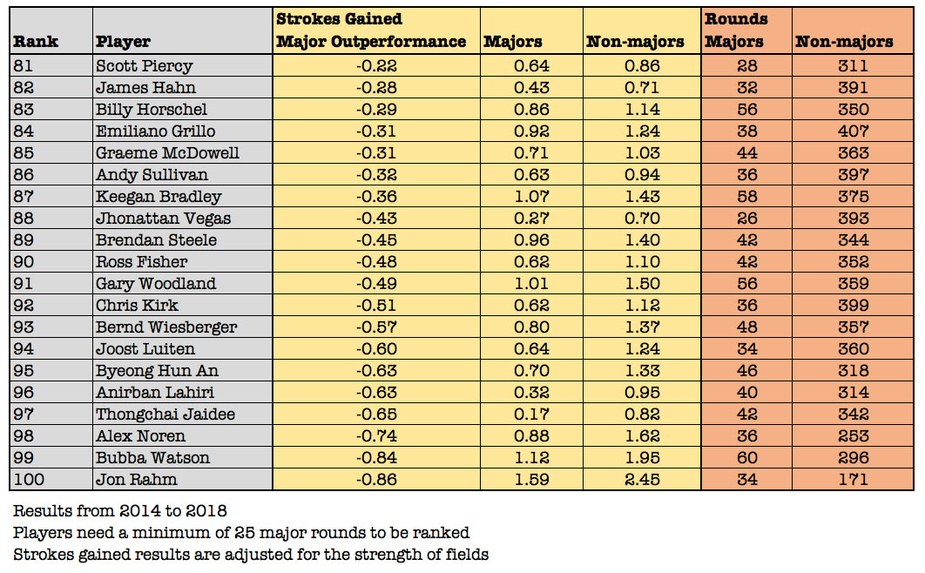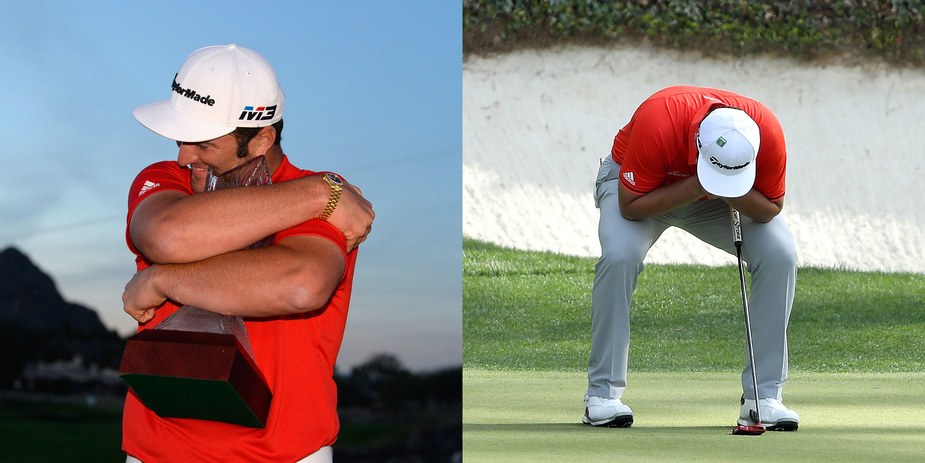The concept of a “gamer” is prevalent in all sports, and many words are spent trying to determine which players are clutch. We hold a special place in our hearts for athletes who seem to excel in situations of intense pressure, and we reserve our purest disdain for those who “choke”. Of course, we’re incredibly prone to misinterpreting the data in these cases, and a player’s early results can often obscure the truth. Mark Twain once said, “Give a man a reputation as an early riser, and he can sleep ’til noon,” and in the same vein, once a reputation for great (or poor) pressure play has been established, it can obscure years of underachievement. Further, we sometimes fail to hold a player to his own standards – a .230 lifetime hitter in baseball who bats .250 under pressure is more “clutch” than a .350 hitter who falls to .320, but too often we forget that pressure play must be measured relatively.
This debate has come to the fore in golf this year because of Brooks Koepka, whose recent results paint him as the sport’s quintessential gamer. Koepka has won just four times on American soil, but three of those titles came in Major championships. As such, he has become golf’s foremost example of “clutch” – someone who has a special aptitude for high-stress tournaments, against excellent competition. But is it true?
One of the benefits of the statistical revolution in golf is that we now have the capacity to test this concept. We want to mention here that the credit for inspiring this piece goes to Jason Sobel at the Action Network, who undertook the task of determining which golfers play best – and worst – at Majors in comparison to their own average standard. It’s a fun article, with interesting results. Yet if there’s one place where we disagree with Sobel, it’s that he used the metric of “average finish by position” as a comparison tool. That may be useful in a general way, but it’s also pretty unscientific. There are large clumps of ties in any given tournament, there are differences in field size and strength (50th at the US PGA Championship is better than 50th at the Masters, and both are way better than 50th at a non-Major), and Sobel’s method of dealing with cuts – counting them all as an 80th place finish – struck us as overly generous, considering there are often 150-plus players in a tournament.
RELATED: Do strokes-gained stats have a sample-size problem?
One of us (Shane) wanted something a little more precise, and reached out to the other, Mark – a Columbia Business School professor and golf statistics guru/pioneer/virtuoso. Mark helped develop the strokes gained/putting metric that has revolutionised how we evaluate professional golfers, which has spread to every part of the game.
As it turned out, strokes gained is also the perfect way to answer this question.
The methodology is intuitive: by looking at how many strokes a player gained against the field in an average Major round, and comparing that to his average strokes gained in a non-Major round (European Tour, US PGA Tour and WGC events), Broadie came up with a simple approach to measure clutch play with a stat we have dubbed Strokes Gained/Major Outperformance. On a basic level, it shows how much better or worse a player fares in the biggest events compared to his own “normal” standard. Broadie also used his statistical wizardry to adjust for strength of field, which is an absolute must for this experiment, since 10th at a Major is infinitely more impressive than 10th at the St Jude Classic.
Another benefit of this method is that it eliminates the need for a separate treatment of missed cuts. Since it only measures rounds the player actually played, it’s a pure look at actual performance instead of theoretical finishes.
We set the parameters from 2014 to 2018, and set the minimum number of Major rounds at 25. As it turned out, there were exactly 100 players who met the criteria. Here’s how the top 20 shook out:

Before we go on, let’s make it absolutely clear what we’re looking at in the chart above. “Strokes gained” as a metric is pretty self-explanatory: it measures how much better or worse a player performs compared to the average player. What we’re doing with this new stat, Strokes Gained/Major Outperformance, is comparing two numbers from a single player. First, his strokes gained in Major championship. Second, his “normal” strokes gained, as measured in “normal” events (i.e. non-Majors). The difference between those two numbers represents how much better or worse he plays in Majors by his own standards. By comparing that number against all qualified golfers, we can see who “steps it up” the most at the year’s biggest events.
No surprise – Koepka is the top dog. With an enormous differential of 1.55 strokes gained per round, Koepka greatly exceeds his own standard. He’s also one of just two golfers, along with Steve Stricker, to post a positive strokes-gained number in more than 90 percent of his Major rounds. (Stricker, fifth on the overall list, leads that category with 92 percent.)
We want to make it absolutely clear that this statistic measures a player against ‘himself’, and nobody else. This is emphatically not a metric that tells us who performs best at Majors overall, and that’s made explicitly clear by the appearance of Darren Clarke on the list at No.13. Clarke is the only player in the top 20 who actually has a negative strokes-gained average at Majors (-1.09). Be that as it may, he still outperforms his non-Major average (-1.88), so by a quirk of the stats, his “outperformance” number ranks among the best. And it tells us something, too – Clarke, now old and past his prime, still has some mixture of wisdom and nerve that lets him play better at Majors.
RELATED: Jason Day is having (statistically) the best putting season ever
It’s also interesting to note that only six of the top-20 players have actually won a Major, which again comes back to the idea that Strokes Gained/Major Outperformance is a stat that rewards consistency and high finishes over time, rather than trophies. In that way, it’s a particularly novel means to look at Major performance, which is almost universally evaluated by wins and wins alone. In a more enlightened world, someone like Stricker might be seen as a stalwart of the biggest events, rather than someone who failed to win the big one (a metric by which he is the greatest without a title), and someone like Tony Finau might be recognised for his nascent aptitude at big events rather than questioned for his Sunday performances.
Now, let’s look at the bottom 20:

The most fascinating entry there, of course, is Bubba Watson, who actually won a Major (the 2014 Masters) in the specific period that we’re measuring. But a look at the rest of his results – 10 cuts in the 19 ensuing events, and only one other top-10 finish – shows exactly why he belongs at 99th. That’s another benefit of Strokes Gained/Major Outperformance: you might have already known that Bubba wasn’t exactly lighting it up in Majors, but without these numbers, would you really understand the extent? (And as a corollary to that, how would Bubba’s career be viewed if one of the four Majors wasn’t played each year on a course tailor-made for a powerful lefty?)
However, it’s worth noting that each player in the bottom 20 still has a positive strokes-gained number in Majors. The main reason is that to be included on this list, a player has to have accrued 25 rounds in Majors. That means we are only looking at the crème de la crème of worldwide players, and those players have an average strokes gained of 1.26 per round – no one in the elite group underperforms in Majors by that much.

Strokes Gained/Major Outperformance answers a very old question, but more than that, it shines a light on what we’ve seen but only half understood with our own eyes. Yes, Jordan Spieth (0.79) has an extra gear in Majors, even when he’s struggling. Yes, Jon Rahm (-0.86) has failed to contain his emotions and find a measure of stability in the biggest events. Yes, Alex Noren (-0.74) seems to light it up every week before disappearing four times per year. Yes, there was something a bit magical about the brief emergence of Victor Dubuisson (0.83).
The fascinating examples don’t end there. As Rickie Fowler (0.55) enters his 30s without a Major, isn’t it more tragic that he’s defined by the lack of a title at tournaments where he excels? Doesn’t it shine a harsh light on players who lack the length to score big at modern Major courses (Graeme McDowell, -0.31) or who have lost their putting touch with the years (Keegan Bradley, -0.36)? Like other great stats, Strokes Gained/Major Outperformance tells new stories while adding colour to old ones. It’s a number that transcends numbers.




